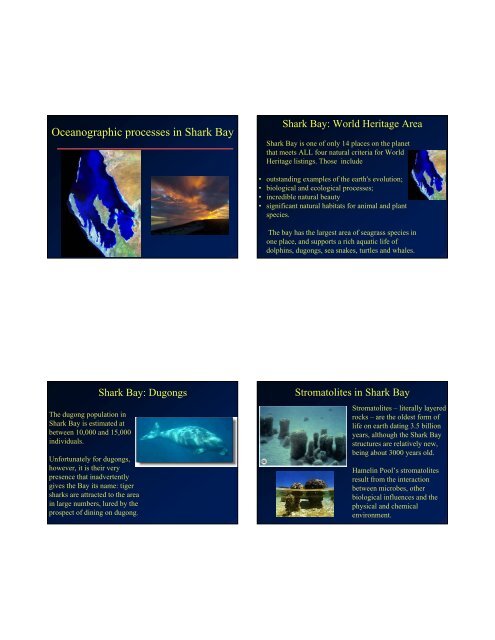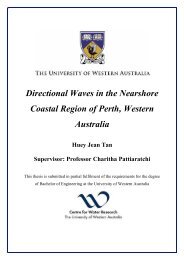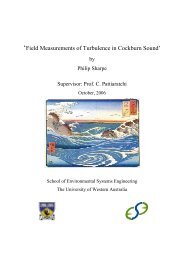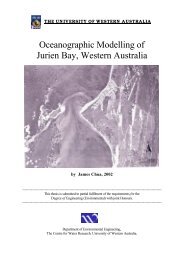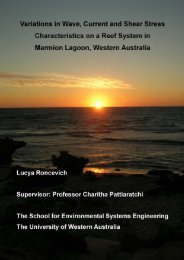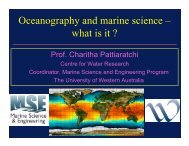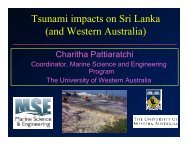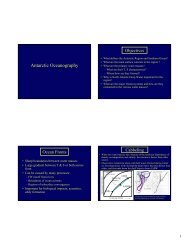Oceanographic processes in Shark Bay
Oceanographic processes in Shark Bay
Oceanographic processes in Shark Bay
- No tags were found...
Create successful ePaper yourself
Turn your PDF publications into a flip-book with our unique Google optimized e-Paper software.
<strong>Oceanographic</strong> <strong>processes</strong> <strong>in</strong> <strong>Shark</strong> <strong>Bay</strong><strong>Shark</strong> <strong>Bay</strong>: World Heritage Area<strong>Shark</strong> <strong>Bay</strong> is one of only 14 places on the planetthat meets ALL four natural criteria for WorldHeritage list<strong>in</strong>gs. Those <strong>in</strong>clude• outstand<strong>in</strong>g examples of the earth's evolution;• biological and ecological <strong>processes</strong>;• <strong>in</strong>credible natural beauty• significant natural habitats for animal and plantspecies.The bay has the largest area of seagrass species <strong>in</strong>one place, and supports a rich aquatic life ofdolph<strong>in</strong>s, dugongs, sea snakes, turtles and whales.The dugong population <strong>in</strong><strong>Shark</strong> <strong>Bay</strong> is estimated atbetween 10,000 and 15,000<strong>in</strong>dividuals.Unfortunately for dugongs,however, it is their verypresence that <strong>in</strong>advertentlygives the <strong>Bay</strong> its name: tigersharks are attracted to the area<strong>in</strong> large numbers, lured by theprospect of d<strong>in</strong><strong>in</strong>g on dugong.<strong>Shark</strong> <strong>Bay</strong>: DugongsStromatolites <strong>in</strong> <strong>Shark</strong> <strong>Bay</strong>Stromatolites – literally layeredrocks – are the oldest form oflife on earth dat<strong>in</strong>g 3.5 billionyears, although the <strong>Shark</strong> <strong>Bay</strong>structures are relatively new,be<strong>in</strong>g about 3000 years old.Hamel<strong>in</strong> Pool’s stromatolitesresult from the <strong>in</strong>teractionbetween microbes, otherbiological <strong>in</strong>fluences and thephysical and chemicalenvironment.
Sea grass <strong>in</strong> <strong>Shark</strong> <strong>Bay</strong><strong>Shark</strong> <strong>Bay</strong> covers about 13000 square kilometres, of which4000 square kilometres are seagrasses, with Wooramel Bankon the eastern side of <strong>Shark</strong> <strong>Bay</strong> cover<strong>in</strong>g 1030 squarekilometres and stretch<strong>in</strong>g along the coast for 129 kilometres,mak<strong>in</strong>g it the world's largest seagrass meadow.LCPhysical Sett<strong>in</strong>gWide cont<strong>in</strong>ental shelf and slope• Tides: transitional region withsemi-diurnal/mixed tides to thenorth and diurnal tides to thesouth• W<strong>in</strong>ds: seasonal changes –strong southerly w<strong>in</strong>ds dur<strong>in</strong>gsummer• Offshore: Leeuw<strong>in</strong> Currentdur<strong>in</strong>g w<strong>in</strong>ter and Capes currentdur<strong>in</strong>g summertides• Density: high evaporation ratesresult <strong>in</strong> strong sal<strong>in</strong>ity gradients<strong>Shark</strong> <strong>Bay</strong>: Seasonal W<strong>in</strong>ds<strong>Shark</strong> <strong>Bay</strong>: Sal<strong>in</strong>itySummerW<strong>in</strong>ter
<strong>Shark</strong> <strong>Bay</strong>: Sal<strong>in</strong>ity gradientsSea Surface Temperature distribution: <strong>Shark</strong> <strong>Bay</strong>MaySepCape PeronSummerW<strong>in</strong>terSea Surface Temperature distribution: <strong>Shark</strong> <strong>Bay</strong>AugDecSurface Chlorophyll distribution (CZCS) : <strong>Shark</strong> <strong>Bay</strong>Feb 1981Jul 1980Mar 1981Oct 1981
Field data collectionT/S diagram of water massesFebruary 1995August 1995June 2000June 2001RV Frankl<strong>in</strong>LCModel Forc<strong>in</strong>gTides: prescribed at boundaryiterative proceduredevelopedW<strong>in</strong>ds:Measured hourly w<strong>in</strong>dsLeeuw<strong>in</strong> Current: <strong>in</strong>flow atnorthern boundary –validated us<strong>in</strong>g LUCIEdataDensity: <strong>in</strong>itial conditions from<strong>in</strong>terpolated field data<strong>Shark</strong> <strong>Bay</strong>: Observed tidestidesw<strong>in</strong>ds
<strong>Shark</strong> <strong>Bay</strong>: M 2 and K 1 tidal components<strong>Shark</strong> <strong>Bay</strong>: S 2 and O 1 tidal components<strong>Shark</strong> <strong>Bay</strong>: variation of tidal constituents<strong>Shark</strong> <strong>Bay</strong>: tidal resonance140kmFor tidal resonanceL = 134 km
Maximum tidal currentsMonkey Mia Lagoon: ebb tideForc<strong>in</strong>g:tides onlyMonkey Mia Lagoon: flood tide<strong>Shark</strong> <strong>Bay</strong>: tidal residual circulationForc<strong>in</strong>g:tides only
P<strong>in</strong>k SnapperDistribution of Snapper (Pagrus auratus) eggsand larvaeDistribution of Snapper (Pagrus auratus) eggsand larvaeLife cycle of Snapper (Pagrus auratus) eggsand larvae
Distribution of Snapper (Pagrus auratus) eggsand larvae + residual circulationDistribution of Snapper (Pagrus auratus) eggsand larvae + residual circulationFreyc<strong>in</strong>et HarbourFaure IslandDirk Hartog IslandCape PeronTide onlyTide onlyTide + LC+ w<strong>in</strong>dJune 1998July 1999Tide + LCTide + LC+ w<strong>in</strong>dAugust 2000January 2000
Particle tracks <strong>in</strong> JuneParticle tracks <strong>in</strong> NovemberApplication to Scallop larvaeApplication to Scallop larvae
Sea Surface Temperature distribution: <strong>Shark</strong> <strong>Bay</strong>AugDecNumerical model results of tracer distributionTidal fronts and mix<strong>in</strong>gStratification parameterTidal frontHeat<strong>in</strong>gmix<strong>in</strong>gTidal flowSimpson-Hunter parameter = h /u 3 or log 10 (h /u 3)
Mix<strong>in</strong>g Processes4.19 x10 -5 1.75 x10 -62.44 x10 -8 2.7 x10 -5Tidal fronts and mix<strong>in</strong>g332 4 24εκDρ ubW g ρ ΒsE α gLE α gQ&Tidal front1 g H ⎛ ∂ρ⎞+ δ κsρa+ + = + ⎜ ⎟3πh h 2 2cp2cp320 ρ Kmz ⎝ ∂x⎠Tidalmix<strong>in</strong>gW<strong>in</strong>dmix<strong>in</strong>gEvaporation Solarheat<strong>in</strong>gBarocl<strong>in</strong>iccirculationmix<strong>in</strong>gInflowTidal flowNear-bed residual currents: barocl<strong>in</strong>ic<strong>Shark</strong> <strong>Bay</strong>: density structure at the entranceOcean Water<strong>Shark</strong> <strong>Bay</strong>Water
Surface Chlorophyll distribution (CZCS) : <strong>Shark</strong> <strong>Bay</strong><strong>Shark</strong> <strong>Bay</strong> outflow <strong>in</strong>to ocean (Frankl<strong>in</strong> 1/96 data)Feb 1981Jul 1980Mar 1981Oct 1981James et al., 2000<strong>Shark</strong> <strong>Bay</strong> outflow: sal<strong>in</strong>ity<strong>Shark</strong> <strong>Bay</strong> outflow: sal<strong>in</strong>ityRV Frankl<strong>in</strong> cruise 10/00RV Frankl<strong>in</strong> cruise 10/00
<strong>Shark</strong> <strong>Bay</strong> outflow: fluoroscenceSurface and near-bed Chlorophyll conc.Nitrogen concentrations arebelow detection levels !!1000 m 1000 mRV Frankl<strong>in</strong> cruise 10/00Surface Photosynthetic rateWater column averaged Production rateSurface (2m) photosynthetic rates25Photosynthetic rate (mgC/m3/d)20181614121086420<strong>Shark</strong> <strong>Bay</strong>1000 m1000 m65 81 83 90 101StationPhotosynthetic rate (mgC/m3/d)20151050<strong>Shark</strong> <strong>Bay</strong>1000 m1000 m65 81 83 90 101Station
Summary• Circulation dom<strong>in</strong>ated by tides <strong>in</strong> Freyc<strong>in</strong>et Reachand Hopeless Reach. Here, w<strong>in</strong>ds and Leeuw<strong>in</strong>Current have negligible effects• Leeuw<strong>in</strong> Current has m<strong>in</strong>imal <strong>in</strong>fluence with<strong>in</strong> the<strong>Bay</strong>. Tidal fronts present <strong>in</strong> Naturaliste andGeographe Channels.• W<strong>in</strong>ds dom<strong>in</strong>ate the northern reaches of the <strong>Bay</strong> –especially dur<strong>in</strong>g the summer months• Outflow of higher sal<strong>in</strong>ity water onto the shelf


